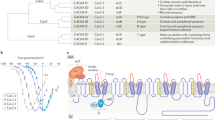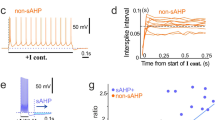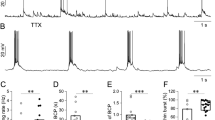Abstract
How many types of calcium channels exist in neurones? This question is fundamental to understanding how calcium entry contributes to diverse neuronal functions such as transmitter release, neurite extension, spike initiation and rhythmic firing1–3. There is considerable evidence for the presence of more than one type of Ca conductance in neurones4–13 and other cells14–18. However, little is known about single-channel properties of diverse neuronal Ca channels, or their responsiveness to dihydropyridines, compounds widely used as labels in Ca channel purification19–21. Here we report evidence for the coexistence of three types of Ca channel in sensory neurones of the chick dorsal root ganglion. In addition to a large conductance channel that contributes long-lasting current at strong depolarizations (L), and a relatively tiny conductance that underlies a transient current activated at weak depolarizations (T), we find a third type of unitary activity (N) that is neither T nor L. N-type Ca channels require strongly negative potentials for complete removal of inactivation (unlike L) and strong depolarizations for activation (unlike T). The dihydropyridine Ca agonist Bay K 8644 strongly increases the opening probability of L-, but not T- or N-type channels.
This is a preview of subscription content, access via your institution
Access options
Subscribe to this journal
Receive 51 print issues and online access
$199.00 per year
only $3.90 per issue
Buy this article
- Purchase on Springer Link
- Instant access to full article PDF
Prices may be subject to local taxes which are calculated during checkout
Similar content being viewed by others
References
Miller, R. J. Trends Neurosci. 8, 45–47 (1985).
Hagiwara, S. & Byerly, L. Trends Neurosci. 6, 189–193 (1983).
Llinas, R., Steinberg, I. Z. & Walton, K. Biophys. J. 33, 323–352 (1981).
Fishman, M. C. & Spector, I. Proc. natn. Acad. Sci. U.S.A. 78, 5245–5249 (1981).
Llinas, R. & Sugimori, M. J. Physiol., Lond. 305, 197–213 (1980).
Murase, K. & Randic, M. J. Physiol., Land. 344, 141–153 (1983).
Nowycky, M. C., Fox, A. P. & Tsien, R. W. Biophys. J. 45, 36a (1984).
Carbone, E. & Lux, H. D. Biophys. J. 46, 413–418 (1984).
Carbone, E. & Lux, H. D. Nature 310, 501–502 (1984).
Yoshii, M., Tsunoo, A. & Narahashi, T. Biophys. J. 47, 433a (1984).
Brown, D. A. et al. IUPHAR Proc. (in the press).
Fedulova, S. A., Kostyuk, P. G. & Veselovsky, N. S. J. Physiol., Lond. 359, 431–446 (1985).
Bossu, J.-L., Feltz, A. & Thomann, J.-M. Pflügers Arch. ges. Physiol. (in the press).
Hagiwara, S., Ozawa, S. & Sand, O. J. gen. Physiol. 65, 617–644 (1975).
Deitmer, J. W. J. Physiol., Lond. 355, 137–159 (1984).
Fox, A. P. & Krasne, S. J. Physiol., Lond. 356, 491–505 (1984).
Armstrong, C. M. & Matteson, D. R. Science 227, 65–67 (1985).
Cohen, C. J. & McCarthy, R. T. Biophys. J. 47, 513a (1985).
Curtis, B. M. & Catterall, W. A. J. biol. Chem. 258, 9344–9348 (1983).
Norman, R. I., Borsotto, M., Fosset, M. & Lazdunski, M. Biochem. biophys. Res. Commun. 111, 878–883 (1983).
Glossman, H., Ferry, D. R., Lubbecke, F., Mewes, R. & Hoffman, F. Trends pharmac. Sci. 3, 431–437 (1982).
Nowycky, M. C., Fox, A. P. & Tsien, R. W. Soc. Neurosci. Abstr. 10, 526 (1984).
Schramm, M., Thomas, G., Towart, R. & Franckowiak, G. Nature 303, 535–537 (1983).
Nowycky, M. C., Fox, A. P. & Tsien, R. W. Proc. natn. Acad. Sci. U.S.A. 82, 2178–2182 (1985).
Kokubun, S. & Reuter, H. Proc. natn. Acad. Sci. U.S.A. 81, 4824–4827 (1984).
Ochi, R., Hino, N. & Niimi, Y. Proc. Jap. Acad. B 60, 153–156 (1984).
Hess, P., Lansman, J. B. & Tsien, R. W. Nature 311, 538–544 (1984).
Brown, A. M., Kunze, D. L. & Yatani, A. Nature 311, 570–572 (1984).
Nilius, B., Hess, P., Lansman, J. B. & Tsien, R. W. Nature 316, 443–446 (1985).
Nachsen, D. A. & Blaustein, M. P. Molec. Pharmac. 16, 579–586 (1979).
Turner, T. J. & Goldin, S. M. J. Neurosci. 5, 841–849 (1985).
Author information
Authors and Affiliations
Rights and permissions
About this article
Cite this article
Nowycky, M., Fox, A. & Tsien, R. Three types of neuronal calcium channel with different calcium agonist sensitivity. Nature 316, 440–443 (1985). https://doi.org/10.1038/316440a0
Received:
Accepted:
Issue Date:
DOI: https://doi.org/10.1038/316440a0
This article is cited by
-
Biofeedback electrostimulation for bionic and long-lasting neural modulation
Nature Communications (2022)
-
Voltage-dependent CaV3.2 and CaV2.2 channels in nociceptive pathways
Pflügers Archiv - European Journal of Physiology (2022)
-
TMS-EEG signatures of glutamatergic neurotransmission in human cortex
Scientific Reports (2021)
-
Giant Y79 retinoblastoma cells contain functionally active T-type calcium channels
Pflügers Archiv - European Journal of Physiology (2021)
-
Skeletal Functions of Voltage Sensitive Calcium Channels
Current Osteoporosis Reports (2021)
Comments
By submitting a comment you agree to abide by our Terms and Community Guidelines. If you find something abusive or that does not comply with our terms or guidelines please flag it as inappropriate.



